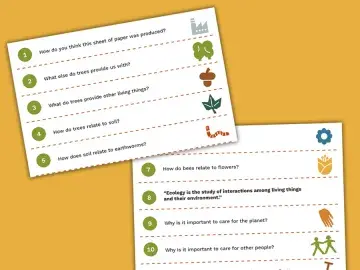
Write a vision statement
You may already have a vision for your learning site overall, but do you have one for your outdoor area?
Creating a vision statement asks learners to imagine what they’d like the future of the site to look like. This can help during idea generation, as well as to keep your Nature Park journey on track as you start to make changes. This will ensure everyone moves in the same direction together and has the same values for your outdoor space. It may also help you find funding as you tell others about your vision for your Nature Park.
After taking part in this activity, we would love you to share your vision with us - share your Nature Park vision statements on social media using #EducationNaturePark
This session could be extended by trying the Write a poem activity, to imagine what message you would like to send about the future of your site.
Preparation
What you need
- A4 or A3 paper for learners’ mind mapping
- Revision cards or slips of paper
- Pens/pencils
- Whiteboard or flipchart paper
Location
Inside
Useful guidance
Resources
Step by step
- Ask learners to think about what they’d like their outdoor space/learning site to be like in the future. Here are some suggested questions that you could prompt children and young people to answer. Ask each question and ask learners to write down a word, phrase, thought or feeling for each – this could be on a mind map, or on separate cards or slips of paper for each answer. When you think about the future of our site/outdoor space...
How would you like it to make you and other people feel?
What would people be able to do?
What would you like to be able to see?
What would you like to be able to hear?
What would it be like for nature? - Now you are ready to start writing your vision statement together. To begin, why not share and discuss the responses to the prompt questions. Were there similarities and differences between the answers collected? Why might this be? What do different people want from your site?
- To help to consolidate everyone’s ideas, in small groups, ask learners to mind map the most important keywords and phrases that they think represent the vision for your learning site – this could be in their usual seating arrangement, or groups of 4-5. As a prompt, you may want to ask, ‘what words come to mind when we think about improving our site?’ These might be emotions, colours, adjectives, or examples of wildlife and nature. For example: nature-rich, safe, engaging, fun, happy spaces, calming, sustainable, community, engaging, energetic, happy, child-centred, outdoor learning, full of play…
- Then, ask each group to create a vision statement using the words and phrases created as inspiration. They don’t have to fit everything in, but they should help to give a good understanding of what we want to achieve.
- It might be helpful to guide the vision statement by asking, ‘what are our goals? What do we want to achieve for our site?’ Think about the problems you want to solve, or the opportunities you would like to seize.
- This can sometimes be a daunting task, so you might like to provide a few starters for sentences – some example ways to start a vision statement could be:
Our Nature Park will be a place where…
We will be….in our Nature Park.
Our vision is a Nature Park where...
Our Nature Park will demonstrate…. - Ask each group to share their vision, and discuss which everyone likes and why. Are any of our visions similar, or very different? There might be favourite bits and pieces from different visions, so work together to put the ‘best bits’ together into one statement.
- Review and tweak this until you are happy with your collective vision for your Nature Park. Why not share with your senior leadership team, display this for everyone to see, and remind you of your vision for your Nature Park journey?
Adapted from 'Learn and Play Out' by Learning through Landscapes.
Curriculum links
This activity can be used to support curriculum knowledge and skill development in English and Citizenship, alongside enhancing nature education, with age appropriate adaptations.
What to try next

Write a poem
Begin activity
A chain from a sheet of paper
Begin activity